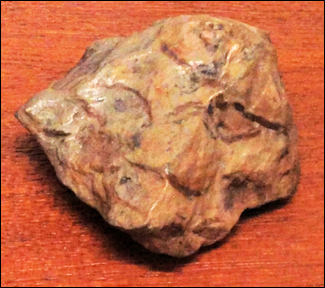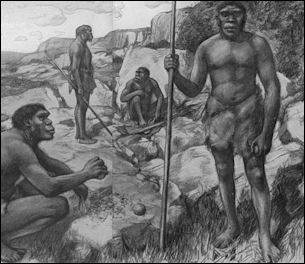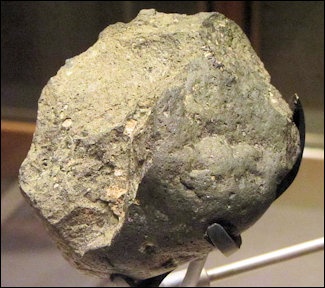HOMO ERECTUS TOOLS

Homo erectus tool from Yuanmou, China
Homo erectus , which first evolved around 2 million years ago, was the first to use fire and sophisticated tools. Unlike earlier hominins that developed crude choppers and flakes,Homo erectus produced sophisticated stone axes and used sharp stone cleavers and finger-size scrapers used slice off chewable sizes of meat. "Tools gave them access to elephants, wildebeest — bonanzas so big they couldn't eat it all," Nick Toth, an archaeologist from Indiana University told National Geographic. Homo erectus made the first wooden spears and first wooden bowls. Using stone anvils and point pressure tools, Homo erectus was able to fashion large tool heads and fine long blades, sharpened on both sides. They made hunting tools with spear points for throwing and thrusting and ax heads for chopping and dismembering carcasses. Perhaps they used cooperative skills in hunting to drive rhinos, elephants or mammoths over cliffs or into swamps.
Blades dated to 240,000 year ago made from long slivers of stones in the Rift Valley are so skillfully crafted from difficult-to-work obsidian and lava, that some anthropologists argue that they required abstract thought to make.
Some tools associated with Homo erectus however were also relatively primitive. The tools found at sites Dmanisi, Georgia consisted of rock “cores” and primitive choppers, not much sophisticated than those made by Homo habilis and possibly Australopithecus.
See Separate Articles: HOMO ERECTUS: BODY FEATURES, DEVELOPMENTS AND SKILLS factsanddetails.com ; HOMO ERECTUS SUBSPECIES, RELATED SPECIES AND FAMOUS FOSSILS factsanddetails.com ; HOMO ERECTUS LIFE, LANGUAGE, ART AND CULTURE factsanddetails.com ; HOMININS, HOMO ERECTUS AND FIRE factsanddetails.com ; HOMO ERECTUS FOOD factsanddetails.com ; HOMININS, HOMO ERECTUS AND COOKING factsanddetails.com ; HOMO ERECTUS AND OUT OF AFRICA THEORY factsanddetails.com ; DMANISI HOMININS —1.8-MILLION-YEAR-OLD HOMO ERECTUS IN GEORGIA factsanddetails.com ; HOMO ERECTUS AND THE FIRST HOMININS IN ASIA factsanddetails.com ; HOMO ERECTUS AND THE FIRST HOMININS IN EUROPE factsanddetails.com
Homo Erectus Hand Axes

Olduvai hand ax Hand axes are usually associated with Homo erectus. Ones found at Konso-Gardula, Ethiopia are believed to be between 1.37 and 1.7 million year old. Describing a primitive 1.5- to 1.7-million-year-old ax, Ethiopian archaeologist Yonas Beyene told National Geographic, "You don't see much refinement here. They've only been knapped away a few flakes to make the edge sharp." After displaying a beautifully-crafted ax from a perhaps a 100,000 year later he said, "See how refined and straight the cutting edge has become. It was an artform for them. It wasn't just for cutting. Making these is time-consuming working."
Thousands of primitive hand 1.5-million- to 1.4-million-year-old hand axes have been Olduvai Gorge, Tanzania and Ubeidya, Israel. Carefully-crafted, sophisticated 780,000-year-old hand axes have been unearthed in Olorgesaile, near the Kenya and Tanzania border. Scientists believe they were used to butcher, dismember and deflesh large animals like elephants.
Sophisticated Homo erectus teardrop-shaped stone axes that fit snugly in the hand and had a sharp edged created by careful shearing of the rock on both sides. The tool could be used to cut, smash and beat.
Big symmetrical hand axes, known as Acheulan tools, endured for more than 1 million years little changed from the earliest versions found. Since few advances were made one anthropologists described the period in which Homo erectus lived as a time of “almost unimaginable monotony.” Acheulan tools are named after 300,000-year-old hand axes and other tools found in St. Acheul, France.
Asian and Australian Early Homo Tools

1.7 million years old
tools from Ethiopia In Eastern sites in China, India and Indonesia, numerous choppers and flakes have been discovered but no hand axes. This has lead scientists to speculate that larger tools may have been made from bamboo or wood. The oldest tools found in Asia include a 1.7-million-year-old flakes found in Nihewan, near Beijing and a crude 600,000-year-old biface found in Yuxian, China.
Sophisticated stone tools found at the 780,000-year-old site of Bose Basin in southern China near the Vietnam border seems to indicate that homonids in Asia developed tools just as advanced as tols made by their cousins in Africa and Europe. For a long time Asian homonids were depicted as being inferior and less sophisticated than homonids in Africa and Europe but the teardrop-shaped tools with double sharp edges found at Bose basin are as developed as this made 500,000 years ago in Europe.
A 116,000-year-old core tool has been found in Jimminum, north Australia.
Homo Erectus as Hunters and Prey
Two thirds of the Homo erectus fossils found Longgushan in China contained damage consistent with that caused by puncture marks from a carnivore’s pointed front teeth, most likely those of a hyena. The puncture marks are more numerous around the face and cranium. Modern hyenas frequently attack and bite the face of their prey first. Facial bones are quite thin and getting at and damaging the brain by crushing the face is an effective way of killing an animal.
Diverse tools made from stone, bone, antler and wood seems to indicate that the first Europeans were hunting and butchering bison, rhinos and elephants as early as 400,000 years ago. Crushed skulls of hunted prey and scavenged animals seems to show they ate brains. They also may have used the fangs of sabertooth tigers as knives.
Five throwing spears, believed to be 400,000 years old, were discovered in a strip mine near Schöningen, Germany (60 miles east of Hannover) in 1995. Carefully crafted with stone tools and resembling modern javelins, the wooden spears were preserved in moist peat. The longest one was over seven feet. It was built with the same balance, the same center of gravity and the same aerodynamic pattern as a modern javelin. It also suggested its users could plan, cooperate and pursue game. A 200,000-year-old spear found in Clacton-on-Sea, England in 1911.
See Separate Article: HOMO ERECTUS FOOD factsanddetails.com
Homo Erectus Groups Hunting

Rhodesian Men English archaeologist Mark Roberts told National Geographic, In Europe "horses my have moved up and down the coast in herds. Almost certainly humans would have been hunting them cooperatively, rather than scavenging them We believe that because we never find butchery marks on top of the tooth marks of scavenging animals. It's always the other way around."
In 1987-88, scientists found the remains of an elephant and numerous dismembered skeletons of giant now-extinct baboons along with 400 flaked tools near Olorgesailie, Kenya. Many bones had obvious cut marks and the meatiest limbs were not present. The tools were made from rock that came from 30 kilometers away. If these animals had indeed been hunted rather than scavenged it would have required great skill to bring down such powerful animals.
Meat and bone marrow also gave Homo erectus energy to grow a larger brain. Perhaps they used cooperative skills in hunting to drive rhinos, elephants or mammoths over cliffs or into swamps. "Before, we doubted that humans had speech this early," Roberts said. "But for this kind of hunting, which would require strategies such as ambush, speech would have been critical."
Homo Erectus Violence and Cannibalism
Homo Erectus skulls found in India show a large number of head wounds. Were these caused by warfare or do they show that erectus was going after big game? It is hard to say for sure. Diseased bones found in Kenya are similar to those of modern humans who have been poisoned by eating too much Vitamin A from animal livers. [Source: Kenneth Weaver, National Geographic, November 1985 [┹]
Skulls dated to be 500,000 years old found in caves in Longgushan China appear to have been severed from the body and preserved, presumably as trophies. The purpose of this may have been to obtain the strength of the deceased. Critics of these claim say the marks made on the skulls were more likely made by giant hyenas than other hominins.
Cut marks made on human bones, similar to those made with Homo erectus tools on butchered animals, have been found in sites ranging from South Africa to Croatia . Some scientists think this indicates that cannibalism may have been part of Homo species behavior for hundreds of thousands of years. One scientist told National Geographic, "They treated their fellow humans the same as other fauna."
DNA studies of people living today contain genes that produce prions — proteins that can be passed by humans that eat other infected humans. This suggest that cannibalism might have once been common among hominins. Prions can also be picked up from eating the meat of infected animals. Another explanation for their presence.
Oldowan Tools

Oldowon tool
The earliest stone tools believed to have been made by the genus Homo are tools from or of the type of found in Olduvai Gorge, Tanzania, where they were discovered in large quantities. Oldowan tools were characterized by their simple construction, predominantly using core forms. These cores were river pebbles, or rocks similar to them, that had been struck by a spherical hammerstone to cause conchoidal fractures removing flakes from one surface, creating an edge and often a sharp tip. The blunt end is the proximal surface; the sharp, the distal. Oldowan is a percussion technology. Grasping the proximal surface, the hominid brought the distal surface down hard on an object he wished to detach or shatter, such as a bone or tuber. [Source: Wikipedia +]
The earliest known Oldowan tools date from 2.6 million years ago and were in Gona, Ethiopia. After this date, the Oldowan Industry spread throughout much of Africa. Archaeologists are currently unsure which Hominin species first developed them, with some speculating that it was Australopithecus garhi, and others saying it was Homo habilis. Homo habilis used them for a long period. About 1.9-1.8 million years ago Homo erectus inherited them. The Industry flourished in southern and eastern Africa between 2.6 and 1.7 million years ago, but also spread out of Africa and into Eurasia with homo erectus, who took Oldowan tool as far east as Java by 1.8 million years ago and Northern China by 1.6 million years ago. +
See Oldowon Tools Under TOOLS FROM THE EARLY HOMO PERIOD factsanddetails.com
Acheulean Tools
More complex Acheulean tools, named after the site of Saint-Acheul in France, developed 1.76 million years ago. Acheulean tools were characterized not by a core, but by a biface, the most notable form of which was the hand axe. The earliest Acheulean ax appeared in the West Turkana area of Kenya and around the same time in southern Africa. Acheulean axes are larger, heavier and have sharp cutting edges that are chipped from opposite sides into a teardrop shape. [Source: The Guardian, Wikipedia +]
In contrast to an Oldowan tool, which is the result of a fortuitous and probably ex tempore operation to obtain one sharp edge on a stone, an Acheulean tool is a planned result of a manufacturing process. The manufacturer begins with a blank, either a larger stone or a slab knocked off a larger rock. From this blank the maker removes large flakes, to be used as cores. Standing a core on edge on an anvil stone, the maker hits the exposed edge with centripetal blows of a hard hammer to roughly shape the implement. Then the piece must be worked over again, or retouched, with a soft hammer of wood or bone to produce a tool finely chipped all over consisting of two convex surfaces intersecting in a sharp edge. Such a tool is used for slicing; using it for pounding would destroy the edge and cut the hand. +

Acheulean hand axes
Some Acheulean tools are disk-shaped, others ovoid, others leaf-shaped and pointed, and others elongated and pointed at the distal end, with a blunt surface at the end, obviously used for drilling. These tools are believed to have often been used for butchering. Not being composite (lacking haft) they are not very useful for killing. Killing had to have been done in some other way. Acheulean tools are larger than Oldowan tools. The blank was ported to serve as an ongoing source of flakes until it was finally retouched as a finished tool itself. Edges were often sharpened by further retouching.
On million-year-old hand axes excavated at Olorgesailie, Kenya, Rhitu Chatterjee of NPR wrote: The oldest innovations were axes designed to be held in the palm of the hand. They were shaped like a tear drop, with a rounded end and a pointed eye. The edges were wavy and sharp. And they look as if they were great at chopping down branches — or chopping up the carcass of a large animal.” "I think of the hand axes as the Swiss army knife of the Stone Age," Smithsonian paleoanthropologist Rick Potts told NPR. The scientists reported their findings in three studies published in the journal Science.[Source: Rhitu Chatterjee, NPR.org, March 15, 2018]
See Oldowon Tools Under TOOLS FROM THE EARLY HOMO PERIOD factsanddetails.com
Smaller More Diverse Tools Become Common Place Around 320,000 Years Ago
Rhitu Chatterjee of NPR wrote: “around 320,000 years ago, the ancient humans seem to have switched to an entirely new technology. The scientists found numerous smaller, flatter, sharper stone tools. "We see a smaller technology, a more diverse series of stone tools," says Potts. These tools were designed for specific purposes — some were used as blades, some as scrapers or spear heads. Scientists reported their findings in three studies published in Science.[Source: Rhitu Chatterjee, NPR.org, March 15, 2018 +++]
“The new studies also show that by 320,000 years ago this technology was well established in the region, suggesting that human ancestors likely started developing it even earlier. It is the full-blown Middle Stone Age," Lahr says. "They have stone tools that are small, that are prepared and retouched, that are made with technique thought to come hundreds of thousands of years later." +++
“The diversity of stone tools from the Middle Stone Age suggests advanced thinking and planning. "The flakes are being much more carefully prepared for a particular purpose," says Alison Brooks, an anthropologist at George Washington University and an author of the three studies. "They are fairly small in size, compared to the technology of earlier people. And in addition, they are made with much finer grained material," which allowed them to better control shapes and sizes of the stone tools."We see the ability to produce small triangular points, that look like they were projectile points," says Potts. "They were tapered at the end, so that could have been put on the shaft of something that flew through the air." In other words, a potentially lethal spear. +++
See Oldowon Tools Under TOOLS FROM THE EARLY HOMO PERIOD factsanddetails.com
Image Sources: Wikimedia Commons, engravings from Science News, Spanish hand ax, Nature
Text Sources: National Geographic, New York Times, Washington Post, Los Angeles Times, Smithsonian magazine, Nature, Scientific American. Live Science, Discover magazine, Discovery News, Times of London, Natural History magazine, Archaeology magazine, The New Yorker, Time, Newsweek, BBC, The Guardian, Reuters, AP, AFP and various books and other publications.
Last updated April 2024
